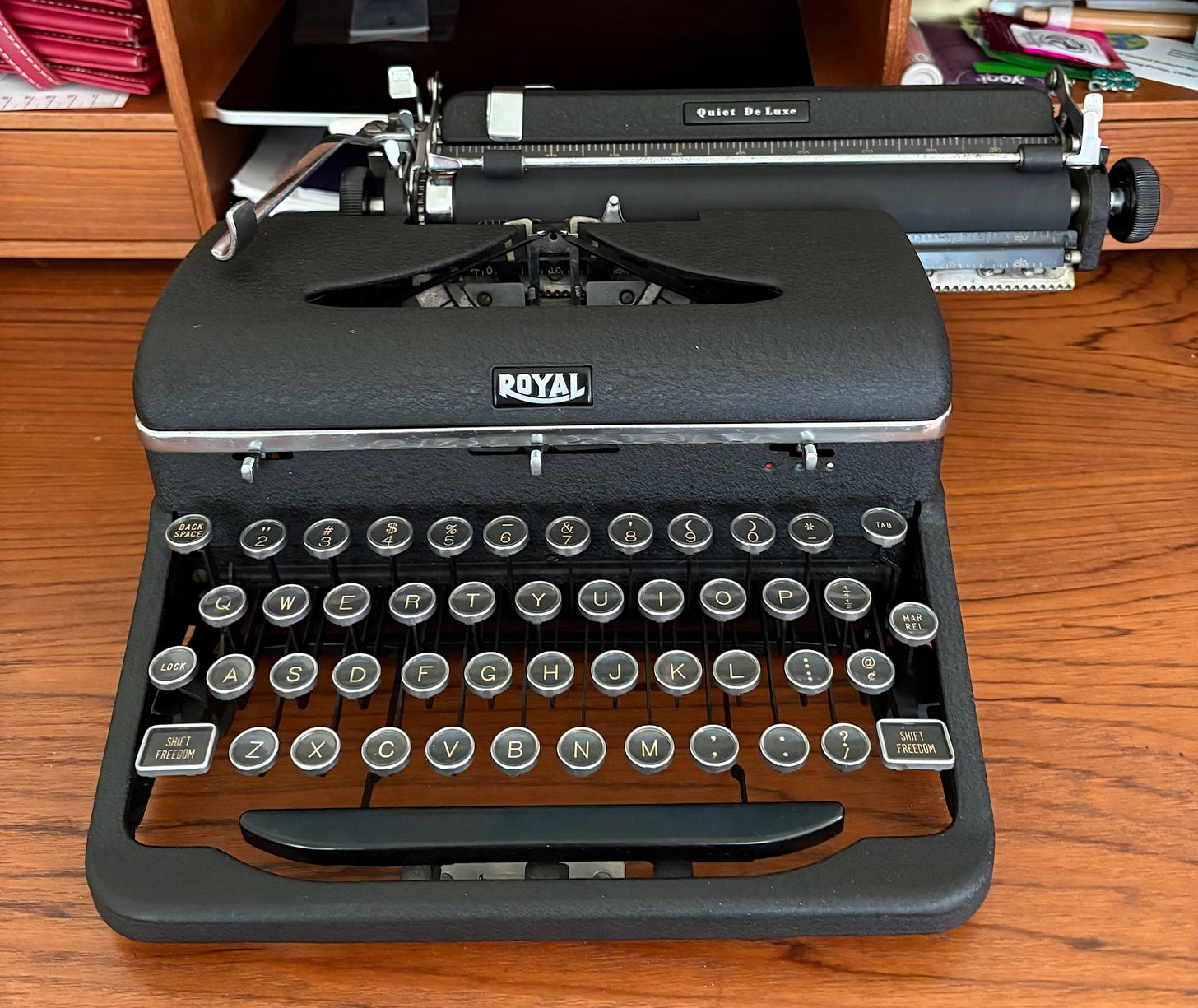You Got This!!!
What the history of the exclamation point reveals about our relationship with our emotions.
I recently received a 1942-era manual typewriter for my birthday. As I typed a “thank you” note to my partner for the gift, I realized there was no exclamation point!
Turns out that for typewriters made pre-1950’s, exclamation marks were considered too informal for business writing, which dominated typewriter use at the time, so unnecessary. It needed to be manually created by typing a period, then backspace, then typing an apostrophe above it to create the shape.
It wasn’t until the 60’s when typewriters became more common in homes, that typewriter companies started targeting students and casual writers and voila, the exclamation mark became a standard feature.
This made me wonder how the exclamation point reflected the evolution of personal expressiveness and informed the positivity of modern day wellness language.
Its Simple Origins
This slender line, standing on a dot, has chronicled our relationship with enthusiasm, emotion, and expression for centuries. It has journeyed from medieval manuscript notation to digital flourish revealing much about our cultural psyche.
Long before we were ending text messages with multiple exclamation points, 15th-century scribes were making a small innovation that would change written communication forever. They began writing the Latin exclamation "io" (an exclamation of joy or hurrah!) by placing the "i" above the "o" — a small space-saving measure that, through centuries of typographical evolution, transformed into our modern mark of excitement.
For most of its existence, the exclamation point led a restrained life. In Jane Austen's entire collection of novels, you might find fewer exclamation points than in a single modern email thread. The Victorians and their predecessors viewed excessive emotion in writing as somewhat gauche — a perspective captured in F. Scott Fitzgerald’s line that using an exclamation point was "like laughing at your own joke." The mark was reserved for moments of genuine astonishment or forceful commands, not everyday enthusiasm.
This restraint began to loosen in the 20th century. Advertising discovered the exclamation point's power to generate excitement ("New and Improved!"), comic books embraced its dramatic potential (Bam!), and gradually, the mark slipped into personal correspondence.
The Beat Poets were big fans too and their use of raw expression brought more authenticity - and exclamations - to the page. Jack Kerouac’s novel, “On the Road” used a lot of exclamation points, which reflected his spontaneous and improvisational voice, influenced by the sound of jazz that inspired him; those exclamation points ringing out like a trumpet horn.
The Digital Revolution
Then arrived the digital revolution. As our communications moved from paper to pixels, something happened to the humble exclamation point. It wasn't just used more frequently; its very function transformed. In a medium stripped of facial expressions, voice modulation, and physical presence, the exclamation point became crucial emotional scaffolding for our disembodied words.
A single exclamation point no longer indicated genuine exclamation but served to convey the warmth and enthusiasm that might otherwise be missed. "Looking forward to the meeting!" reads differently than the stark "Looking forward to the meeting." The exclamation point had become less about shouting and more about smiling.
This evolution didn't happen in a cultural vacuum. The exclamation point's liberation coincided with broader shifts in how we approach emotions, self-expression, and personal growth. As the self-help movement gained momentum in the 1970s and 80s, with its emphasis on positive thinking and emotional expression, our punctuation followed suit. The use of exclamation points grew, encouraging readers to break free from emotional restraint.
This connection between punctuation and personal growth became even more pronounced with the rise of wellness culture in the 2000s and 2010s. Scroll through any wellness influencer's social media and count the exclamation points. "Listen to your body!" "You've got this!" "Self-care isn't selfish!" The mark has become the typographical embodiment of the movement's emphasis on positivity.
The corporate world has embraced this trend too, with office emails increasingly punctuated by enthusiasm, especially in the United States. Studies show professionals (particularly women) often feel compelled to use exclamation points to avoid appearing cold or unfriendly.
The exclamation point has now become far more than just punctuation. It's a cultural artifact that tracks our evolving relationship with emotion, authenticity, and social connection. From medieval scribes to wellness influencers, from Victorian restraint to digital enthusiasm, its journey reflects our ongoing negotiation with how much emotion we're willing to express on the page — and in our lives.
The Wellness Voice!
I’m not sure if it’s possible to tie this back to wellness travel but since that’s what this Substack is about, I’ll try. There is a kind of emotional off-gassing that happens when your friend texts you about joining her for “a weeklong yoga retreat in Bali!” If it wasn’t for the exclamation point, would it be so exciting?
For brands, it’s also a reflection of voice and personality. Luxury resorts rarely use these in their website copy. Could you imagine an Aman website exclaiming, “Come stay with us!”? I don’t think so. But for a younger, more exuberant brand like Moxy or Ovolo (below), exclamation points capture a vibe.
I’m not sure if it’s the chicken or egg, if human emotional evolution led to the greater adoption of the exclamation point or if that punctuation nudged us with every keystroke towards feeling more openly excited but the next time you hover over that exclamation point key, which is now ubiquitous, consider what you're really communicating. In that tiny vertical stroke topped with a dot lies a surprising amount of cultural baggage and emotional complexity. Use it wisely! Or don't. The choice itself says more than you might think.





